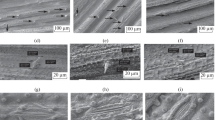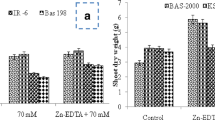Summary
Oryza coarctata, a highly salt-resistant wild rice species, is commonly found on the banks of coastal rivers in India. This species can also withstand saline water (20 to 40 dSm−1 E.C) submergence for quite a long period. It was revealed thatO. coarctata has some special unicellular salt hairs (trichomes) on the adaxial surface of the leaves, by which they efficiently maintain a low concentration of toxic salts in the plant tissue. Sodium and chloride were the dominant ions in the excreted material but they also excrete potassium, magnesium and calcium. With the increase in soil salinity sodium, magnesium and chloride excretion increased.O. coarctata maintained the optimum mineral concentration in its tissues. Maximum accumulation of potassium was observed in the leaves. With the increase in salt stress total biomass production and osmotic potential increased over control but there was no change in the moisture percentage of leaves.
Similar content being viewed by others
References
Arisz W H, Camphuis I J, Hckiens H and Van Tooren A J 1955 The secretion of the salt gland inLimonium latifolium. Acta Bot. Neerl. 4, 322–326.
Bal A R 1975 A note on the comparative study of free aminoacids content between wild salt tolerant rice and cultivated rice varieties. Curr. Sci. 44, 194–195.
Chalam G V 1943 Comparative studies on the anatomy of two wild species in the genus Oryza. Ph. D. thesis, Part-II, Patna University.
Hedayetullah S and Chakravorti A K 1941, Mechanical system in five species of the genusOryza. J. Dept. Sci., Bengal, N. S. 1, 21–48.
Johansen D A 1940. Dehydration. Plant Microtechnique 130–132.
Liphschitz N and Waisel Y 1974 Existence of salt glands in various genera of the Graminese. New Phytol. 73, 507–513.
LuttgeU 1971 Structure and function of plant glands. Annu. Rev. Plant Physiol. 22, 23–44.
Richharia R H and Roy J K 1965 Anatomical studies in the genus Oryza-I. Anatomy of Oryza coarctata in relation to its systematic position in the genus. Oryza 2, 1–9.
Ruhland W 1975 Untersuchungen Uber die Hautdrusen der Plumbaginaceen. Fb. nist. Bot. 55, 400.
Tateoka T 1963 Notes on some grasses. XIII. Relationship between Oryza and Ehrharteae, with special reference to leaf anatomy and histology. Bot. Gaz. 124, 264–270.
Walter H and Steiner M 1936 Die Okologie der Ost-Afri-Kanischen Mangroven. Z. Bot. 30, 85–90.
Author information
Authors and Affiliations
Rights and permissions
About this article
Cite this article
Bal, A.R., Dutt, S.K. Mechanism of salt tolerance in wild rice (Oryza coarctata Roxb). Plant Soil 92, 399–404 (1986). https://doi.org/10.1007/BF02372487
Received:
Revised:
Issue Date:
DOI: https://doi.org/10.1007/BF02372487




